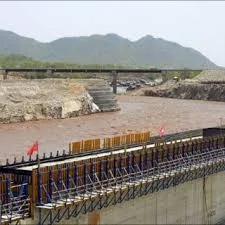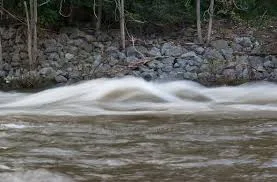Definition: A hydraulic jump is a phenomenon in open channel flow (rivers, spillways) where rapidly moving water transitions to slower, deeper flow. This abrupt change creates a turbulent zone with a characteristic rise in the water surface.
Click the Translate button(see right) on this post to set your Own Language to understand more perfectly!!
Hydraulic Jump Calculator
Hydraulic Jump Calculator
Continue Definition:
Hydraulic Jump
A hydraulic jump is a phenomenon in open channel flow (rivers, spillways) where rapidly moving water transitions to slower, deeper flow. This abrupt change creates a turbulent zone with a characteristic rise in the water surface. Here's how the factors you mentioned influence a hydraulic jump:
Factors:
Flow Rate (Q₁ in m³/s):
Impact: Directly affects the momentum of the incoming flow. Higher flow rates lead to larger and more energetic jumps.
Sample Value: A small stream might have a flow rate of 2 m³/s (Q₁ = 2 m³/s).
Upstream Depth (H₁ in m):
Impact: Represents the depth of the flow before the jump. Shallower upstream depths can result in larger jumps due to the need for a more significant water level increase.
Sample Value: The upstream depth in a channel could be 1 meter (H₁ = 1 m).
Downstream Depth (H₂ in m):
Impact: Represents the depth of the flow after the jump. The jump characteristics depend on the relative difference between upstream and downstream depths.
Sample Value: The downstream depth might be 2 meters (H₂ = 2 m) due to the channel geometry.
Acceleration due to Gravity (g in m/s²):
Impact: A constant that influences the force acting on the water, affecting the jump's hydraulics
.
Sample Value: Acceleration due to gravity is approximately 9.81 m/s² (g = 9.81 m/s²).
Example Calculation:
While there's no single equation to directly calculate all jump characteristics, we can estimate the downstream depth (H₂) using the Bélanger equation, a common relationship for hydraulic jumps:
H₂ / H₁ = (1 + √(8 * F₁² - 1)) / 2
where F₁ is the Froude number at the upstream section:
F₁ = Q₁ / (B * H₁^(3/2) * g^(1/2))
B represents the channel width (not given here).
Let's assume:
Q₁ = 5 m³/s
B = 4 meters (typical channel width)
H₁ = 0.5 meters (shallow upstream depth)
g = 9.81 m/s²
Calculate F₁:
F₁ = 5 m³/s / (4 m * (0.5 m)^(3/2) * (9.81 m/s²)^(1/2)) ≈ 2.24
Calculate H₂:
H₂ / 0.5 m = (1 + √(8 * 2.24² - 1)) / 2
H₂ ≈ 1.75 meters
This is an estimated value. In real-world scenarios, more complex calculations and considerations like energy dissipation and turbulence are necessary for accurate hydraulic jump analysis.
Other Suggestions:
Hydraulic Jump Types: Hydraulic jumps can be classified based on their characteristics, such as streaming jumps (smooth transition) and wave jumps (oscillating flow).
Applications: Understanding hydraulic jumps is crucial for designing spillways in dams, weirs for flow control, and stilling basins to dissipate energy in channels.
Software Tools: Computational fluid dynamics (CFD) software can be used to model hydraulic jumps more accurately, considering factors like channel geometry and surface roughness.
By understanding the factors influencing hydraulic jumps and their calculations, you can gain valuable insights into open channel flow behavior and its applications in various engineering fields.
How it is possible to Earn Money using the knowledge of hydraulic jump Calculation in our practical life?????
Here's how your knowledge of hydraulic jump calculations can translate into earning money in various fields:
Direct Applications:
Water Resources Engineering: This is the most direct application. Engineering firms involved in dam design, spillway construction, canal systems, and river management require expertise in hydraulic jumps. You could be involved in:
Designing Spillways: Ensuring spillways effectively handle excess water flow during floods often involves calculating hydraulic jumps to dissipate energy and prevent erosion downstream.
Canal Design: Understanding hydraulic jumps helps optimize canal geometries to maintain efficient water flow and avoid unintended energy dissipation.
River Management: Hydraulic jump calculations play a role in designing structures for riverbank stabilization and flood control, considering how jumps affect flow patterns and scour potential.
Hydropower Plants: The design of hydropower facilities often involves managing water flow through channels and penstocks. Your knowledge can be valuable in:
Intake Structures: Ensuring smooth water transition into the turbines requires considering hydraulic jumps to avoid inefficiencies or damage.
Tailrace Channels: Dissipating energy efficiently after water exits the turbines might involve designing features that utilize hydraulic jumps.
Environmental Engineering: Understanding hydraulic jumps can be applied in projects like:
Stormwater Management: Designing detention ponds or basins to control stormwater runoff often involves calculating jumps to manage flow rates and prevent flooding.
Coastal Engineering: Hydraulic jumps can occur where rivers meet the ocean. Your expertise can be valuable in designing coastal structures that consider these interactions.
Indirect Applications:
Research and Development: Companies or institutions developing new technologies related to flow control or energy dissipation in water systems might benefit from your expertise in hydraulic jump analysis.
Software Development: Companies creating software for hydraulic simulations or dam safety analysis could value your knowledge to ensure the software accurately models hydraulic jump behavior.
Consulting Engineering: With experience, you could become a consultant, offering expertise in hydraulic jump calculations to various engineering firms or government agencies involved in water resource projects.
Additional Tips:
Gain Experience: Practical experience with hydraulic modeling software and real-world projects will strengthen your expertise.
Stay Updated: Hydraulic engineering practices and design codes evolve. Keep yourself updated on the latest developments.
Develop Soft Skills: Communication, teamwork, and problem-solving skills are crucial for collaborating effectively in engineering projects.
By effectively applying your knowledge of hydraulic jump calculations, you can position yourself for rewarding opportunities in water resources engineering, hydropower, environmental fields, and related sectors.
Do YOU Want To Earn Money In Various Ways, Click The Link & Explore Your Field of Interest!!!







